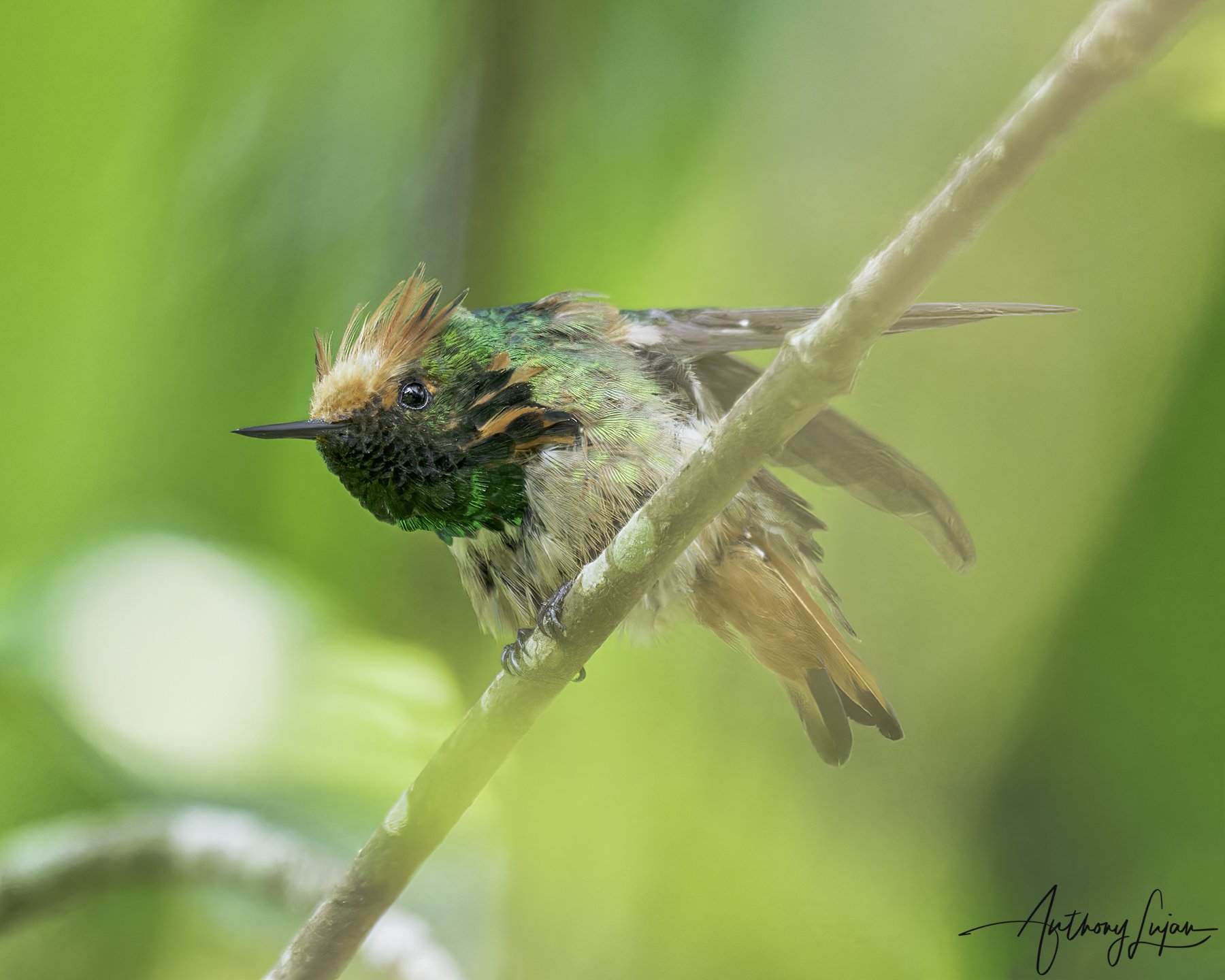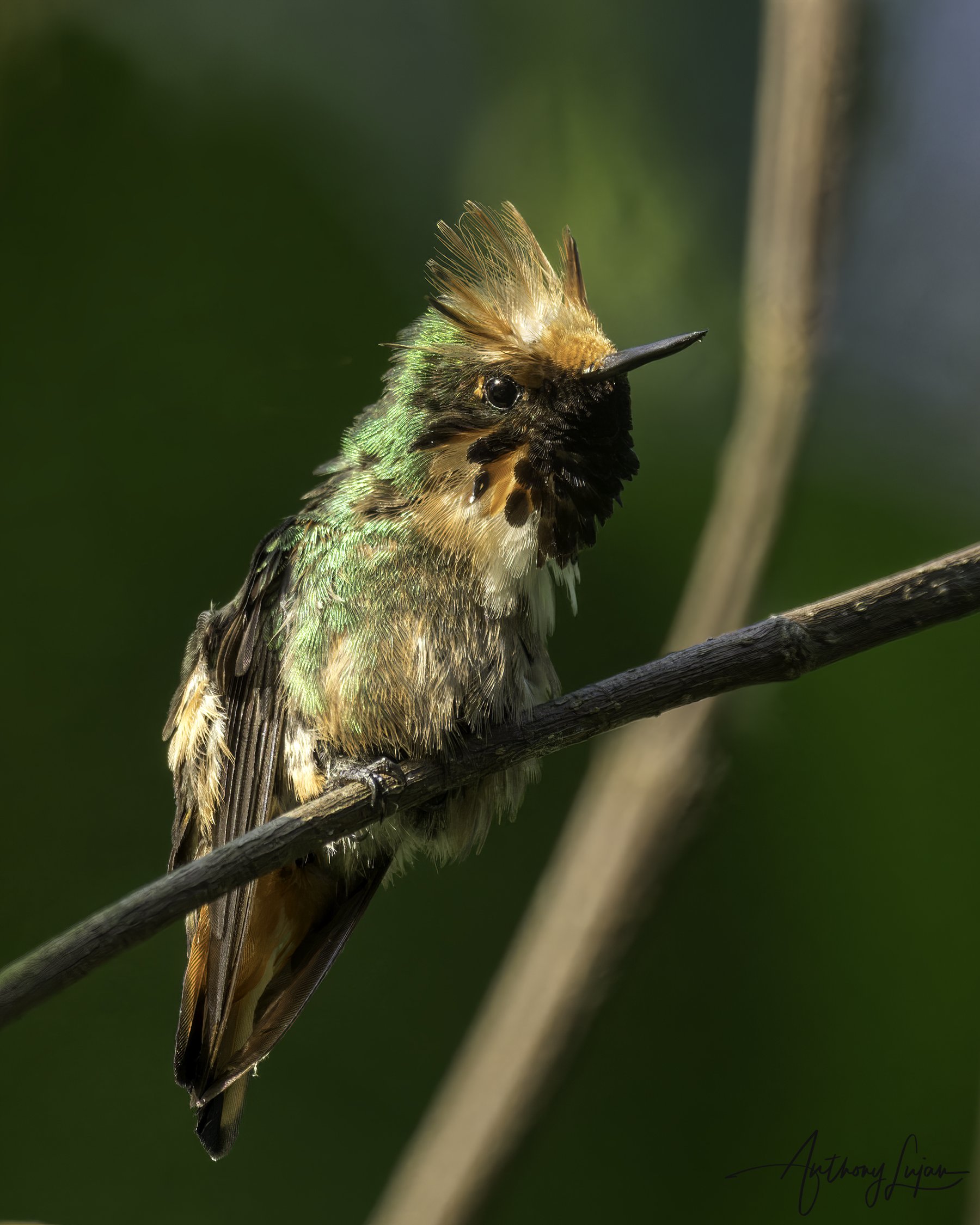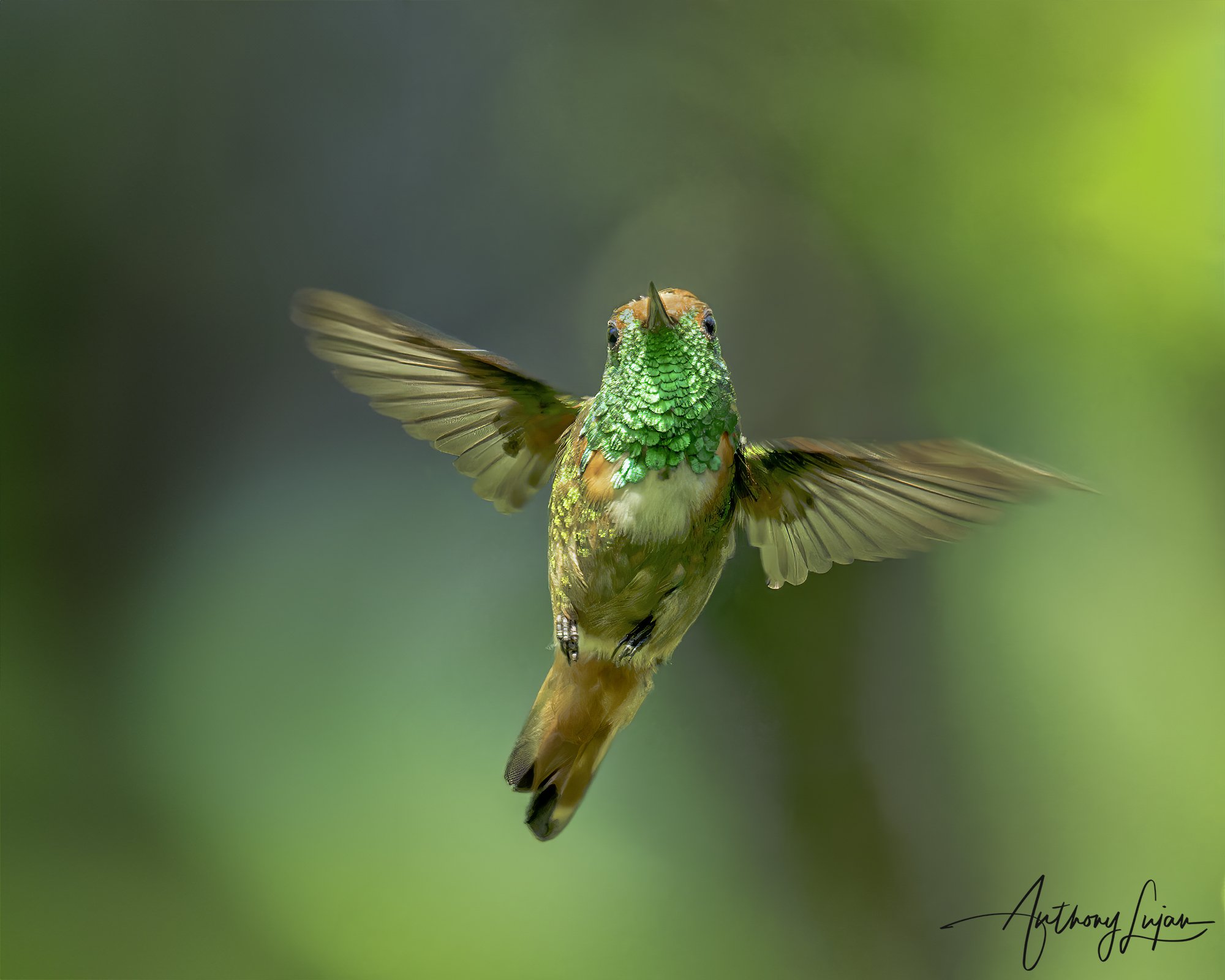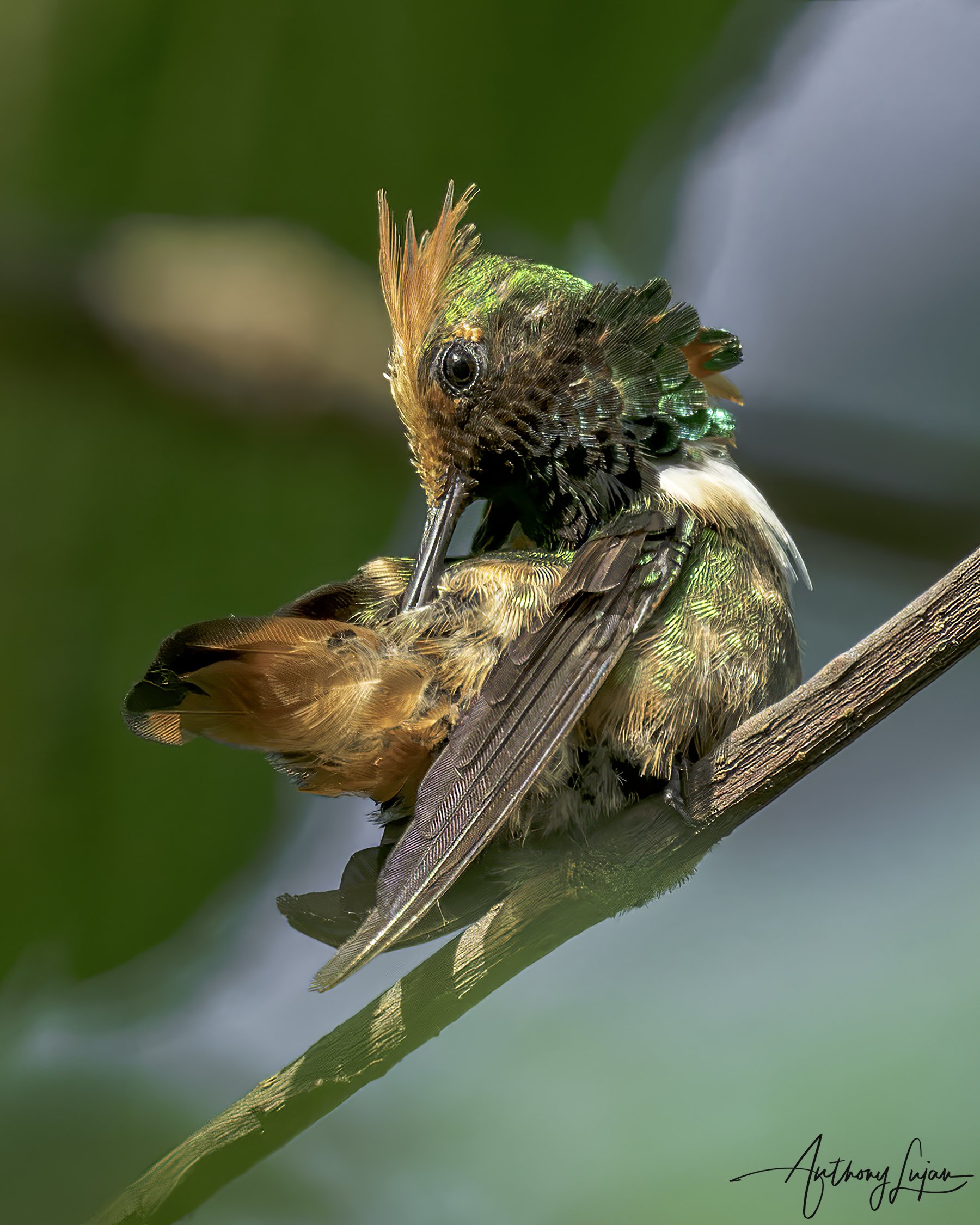How I Photographed the Short-crested Coquette
Sony A1, Sony 600mm
f/4, 1/1600, ISO 1600
The Short-crested Coquette (Lophornis brachylophus) is a critically endangered hummingbird species that stands out among the 56 hummingbird species listed on the IUCN's Red List. With its short, spiky orange crest, green throat, and rusty tail surfaces, the male Short-crested Coquette is a true spectacle of nature's artistry.
Journey to Discover the Elusive Beauty
Endemic to the Atoyac region in Guerrero, Mexico, the Short-crested Coquette is a rare and elusive bird that has long evaded clear, crisp photographic documentation. Capturing its beauty became my mission, and understanding its habitat and ensuring the region's safety were crucial steps.
I consulted Ernesto Pérez, a knowledgeable guide and biologist familiar with the hummingbird, who reassured me of our chances. He cited the blooming flowers and the overall safety of the Guerrero region. Despite concerns from friends and fellow photographers, I decided to move forward and book my trip, feeling nervous and excited.
The Team and the Adventure
Upon arriving in Mexico, I was greeted by Ernesto and his friends, Andre and Cesar. Ernesto, my overall guide, had extensive knowledge of the region. Andre, who knew the local people in Atoyac, and Cesar, our driver and car owner, completed our team. Although our car was a bit beat up and lacked air conditioning in the 90+ degree heat, we made it work. Trusting in the expertise and goodwill of my new friends, we set off on our quest.
The First Encounter
We arrived late afternoon, and frustrations marked our first day. At dusk, we finally spotted a female coquette high on a Canallito (Miconia xalapensis) tree, feeding on its fruit. Despite having my Sony A1 and Sony 600mm f/4 lens, capturing the moment was challenging due to the changing light, the bird's quick movements, and the tree's height (30-33 feet). Adding to the frustration, a male would occasionally approach, only to be swiftly chased away by the female. This was our first encounter with a male coquette, and to have him being chased away was obscene! Come on now! Nevertheless, I captured some great photographs of the female by stepping back to create a more eye-level perspective. From my knowledge, the first crystal clear images of the female not only perched but also feeding on this fruit. You can visibly see the wholes they create to get the nectar out. Who knew!
All images above were taken with:
Sony A1, Sony 600mm
f/4, 1/1250, ISO 6400
A Lesson Learned
Although initially disheartening, this encounter provided valuable insight into the coquette's behavior. Observing the female pecking at the fruit to obtain nectar, we realized the significance of the Canallito tree and decided to focus our efforts there in the morning.
Sony A1, Sony 600mm
f/5.6, 1/1000, ISO 1000
Sony A1, Sony 600mm
f/5.6, 1/1250, ISO 1000
Sony A1, Sony 600mm
f/5.6, 1/1250, ISO 1000
The Triumphant Morning
The following morning, just before dawn, we returned to the same property with our attention fixed on the Canallito tree. As sunlight improved, someone spotted a male Short-crested Coquette feeding on blooming flowers of a different tree around the other side of the house. This tree was standing about 18-20 feet tall. Filled with excitement, we hurried to that tree's location. With better lighting, I stepped back to get close to eye-level angles, looking for the best background and capturing some remarkable images and videos.
Capturing the Essence
After immortalizing the moment with a series of photos and videos, I had to take a moment to savor the experience. Amid celebratory high-fives and hugs from our team, I felt humbled, exhilarated, and moved. Photographing this rare, critically endangered hummingbird was an incredible experience, driven by my desire to do justice to its beauty and share it with the world. I felt like this species had no voice and that people needed to know about it. Over the following days, I was fortunate to capture more images of the male, and a juvenile male, preserving their essence for eternity.
Visit Ernesto Pérez’s guide page on my website.
Today, my images and videos of the Short-crested Coquette are represented on eBird for this species. The main image is my guide Ernesto’s and the others on the right are mine including both female and male with the shinning green gorget.
It was such a proud moment when I was asked to have my photographs and videos featured in a documentary dedicated to saving this species. It’s a privilege to contribute to raising awareness about this awe-inspiring hummingbird and ensuring that its beauty is known to the world. Amazing people are protecting its habitat, and it has a great chance to survive so future generations can take in the beauty of the Short-created Coquette.
I was honored to be featured on the cover of the prestigious Wildlife Photographic Magazine, accompanied by an article I wrote about “Elusive Hummingbirds.” This wonderful issue prominently showcases my stunning photograph of the Short-crested Coquette, which graces the cover.
Conclusion
Embarking on this adventure was more than just a photographic journey; it was a profound connection with nature and an opportunity to highlight the importance of conservation and awareness. Witnessing the Short-crested Coquette in its natural habitat was a reminder of the fragile beauty that exists in the world and our responsibility to protect it.
Please note: The content provided here reflects Anthony’s personal experience as a dedicated photographer and details the specific methods he has utilized to successfully photograph this particular hummingbird species. It is important to understand that many complex factors are at play in the world of photography, and therefore not everyone may have the same experiences or outcomes as Anthony. Individual circumstances, varying levels of expertise, camera gear, and distinct approaches can all significantly influence the final results.














